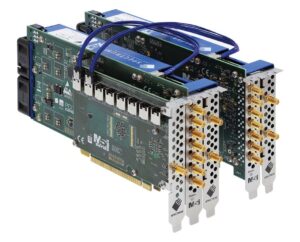Multi-channel data acquisition made easy—at sampling speeds up to 10 GS/s!
Bangalore, India, October 25, 2023: A new option from Spectrum Instrumentation offers a user-friendly way to create multi-channel data acquisition systems with ultrafast sampling speeds up to 10 GS/s. Called Star-Hub, the option allows up to eight of the company’s flagship PCIe digitizers (M5i.33xx series) to be connected together. Individual cards then share a common clock and trigger signals, which ensures there is minimal phase delay and timing skew between all the channels. The Star-Hub option is installed by mounting a single piggyback module onto any of the M5i series cards in the multi-channel system. Using accurately matched and shielded coax cabling, the board then distributes the clock to each module and precisely synchronises the trigger event with the system clock.

Star-Hub can be used with any of the cards from the M5i.33xx digitizer family. Seven different models are available, offering one or two channels, sampling rates from 3.2 to 10 GS/s, 12-bit vertical resolution, and bandwidths from 1 to 4.7 GHz. The cards can handle a wide range of signals and feature programmable input voltage ranges, offset control, large on-board memories, advanced trigger functions, and a number of different acquisition modes. Together with Star-Hub, the line-up lets you build data acquisition systems with from 2 to 16 channels, sampling at rates of up to 5 GS/s, or up to 8 channels at the maximum sampling rate of 10 GS/s.
Users can also choose to run the Star-Hub system with the digitizer card’s internal clock, which offers better than ±1 ppm accuracy, or an external clock via a front panel SMA input connector. To minimise any channel-to-channel timing skew, there is a programmable skew adjustment available for each connected card. This feature allows time shifts up to 200 ps (10 GS/s) or 312 ps (3.2 and 6.4 GS/s) of the clock of each individual card. It thus creates an easy way for users to correct any timing mismatches that may be present in their specific setup.
The ability to create customised multi-channel data acquisition systems that can synchronously acquire signals in the GHz range is ideal for a wide variety of applications. For example, they can provide a unique measurement solution in fields like communications, automated testing, aerospace, and scientific experimentation, where banks of receivers, detectors, sensors, or antennas are deployed.
Fast data transfer for processing and storage
Another advantage of the Star-Hub system is that each card retains its own 16-lane Gen3 PCIe bus that is capable of transferring data at rates up to 12.8 GB/s. This transfer speed allows continuous transfer at 6.4 GS/s in 12-bit mode or even 10 GS/s in data-saving 8-bit mode. The bus allows the cards to shift acquired data to PC resources like memory, SSDs, and GPUs at exceptionally fast speeds, even though they are all controlled by a single host processor.
Multi-channel control and display
Specifically designed for multi-channel systems, the company also has its own measurement software called SBench 6 Professional. This interactive GUI can control all the cards connected to StarHub. It runs on PCs using either Windows or Linux operating systems and provides complete instrument control, along with display, analysis, storage, and documentation capabilities. SBench 6 can handle large data files and has a number of processing tools, including a plug-in interface that allows the use of custom calculation functions. There are also cursor and parameter functions that enable cross-channel measurements, as well as a variety of import and export filters.
Software Development Kit
Every M5i digitizer is also shipped with a software development kit (SDK) as standard. The SDK allows them to be programmed with almost any common language. This includes C, C++, Python, C#, Delphi, VB.NET, J#, Julia, Java, LabVIEW, and MATLAB. The SDK contains an assortment of programming examples and all the driver libraries necessary for running under a Windows or Linux operating system.
Care-free operation
Oliver Rovini, CTO at Spectrum, said: “Providing an easy-to-use solution for the multi-channel acquisition of signals in the GHz range is something our customers have been requesting for some time. However, when using modular instruments, this is not a simple task. You need to deal with clock systems designed to handle a variety of rates and typically use a phased lock loop (PLL) type architecture. Furthermore, each card has its own trigger circuitry that uses comparators to detect trigger level crossings. At the speeds we are working at, any small differences in these reference levels can easily produce unwanted jitter. The beauty of Star-Hub is that it takes care of these issues so the user doesn’t have to! The setup is straight forward, and once the cards are connected together, our drivers manage all the necessary clock and trigger distribution conditions for you.”
The Star-Hub option is available now and can be ordered with any new M5i.33xx series digitizer cards.
Do Follow: CIO News LinkedIn Account | CIO News Facebook | CIO News Youtube | CIO News Twitter
About us:
CIO News, a proprietary of Mercadeo, produces award-winning content and resources for IT leaders across any industry through print articles and recorded video interviews on topics in the technology sector such as Digital Transformation, Artificial Intelligence (AI), Machine Learning (ML), Cloud, Robotics, Cyber-security, Data, Analytics, SOC, SASE, among other technology topics.






